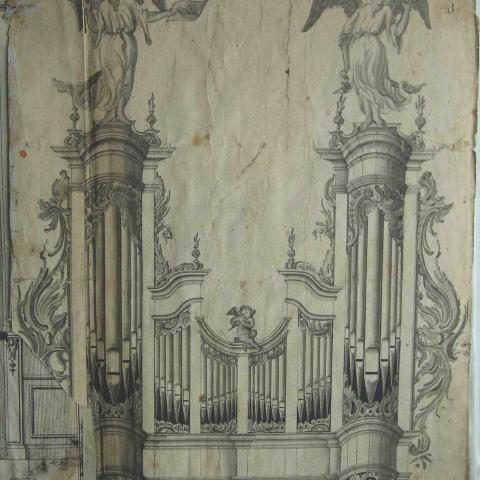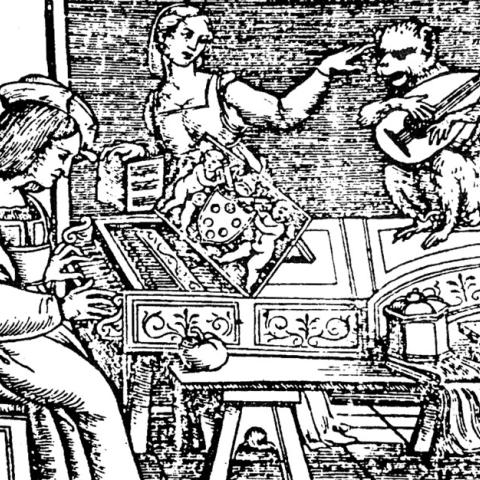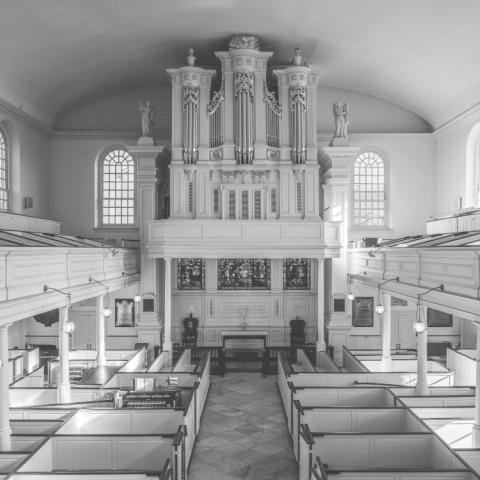Dr. Girenas Povilionis is associate professor at the Lithuanian Academy of Music and Theater. He is a senior specialist at the Center for Culture Heritage, an organ historian, researcher and restorer, and gives lectures at the Lithuanian Academy of Music and Theater and Grigalius Center for Church Music Studies. Since 2012 he has been a member of the Commission for the Certification of Movable Cultural Property Restorers. A more complete biography will appear with the part 2 of this series. For more information: www.vargonai.com.
Historical background
The Old and Rare Books Department at the library of Vilnius Academy of Arts, Lithuania, stores a unique collection of drawings and prints depicting works of art (e.g., altars) dating from the latter part of the eighteenth-century Ruzne rysunki.1 This leather-bound album of drawings is believed to have belonged to the altar maker Jonas Danauskas, as one of the pages contains his name and surname as well as the date 1878; there is a date inscription (1879 roku 24 lipca /July 24, 1879) on the inside back cover. Next to the date the drawings and prints are listed by the artistic style they represent, and a separate list of ten organ façade designs (numbers 6, 7, 9, 11, 13, 16, 18, 21, 23, and 25) is provided.
Judging from the different kinds of paper used to glue authentic drawings and prints as well as from the consistent and methodical style of list making and handwriting, similar to that of Danauskas, which the lists reveal, it can be assumed that the album was his. However, the altar maker most probably was not the first compiler of the collection; he just added his own altar drawings and other images to the old album of prints and drawings. Stamps on the front pages point to subsequent owners of the collection including Kaunas School of Arts (hardly legible), Kaunas Institute of Applied Arts, and from 1953, Vilnius Academy of Arts Library (the album has been part of the Old and Rare Books collection since 1992).
The album also includes some pages featuring ten authentic organ façade drawings dating from the latter part of the eighteenth century, and two organ façade prints cut from a French or German book, which are of inestimable value to the history of Lithuanian pipe organs. In fact, this manuscript is also significant to the European history of pipe organs at large. The Polish art historian Marcin Zglinski began study of these drawings as far back as 1999,2 yet he did not manage to read and fully decode some of the authentic inscriptions. Therefore, there are certain inaccuracies in the published works by Zglinski including inaccurate attribution of several organ designs to specific authors and erroneous or imprecise indication of some locations.
With light blue shading in some places, the organ designs were drawn in ink on paper with different watermarks, heraldic images on some pages, and regular illuminated lines on the other. The authorship of the drawings has not been fully determined, since the collection had several owners before it ended up in its current storage place. Yet, as we know, the architectural structure of an organ façade was inseparable from the instrument in the eighteenth century and was most often designed by the organ builder. Therefore, it is likely that the drawings were made by the same organ builders or were commissioned by them to be made after their own sketches. The authors’ professional excellence is witnessed by an extremely detailed and masterful execution of even the finest lines. Based on the drawing techniques, handwriting, style, and factual circumstances, the designs can be separated into five groups that will be discussed further in the article.
Drawing numbers 18 and 21
Featuring the same architectural structure, drawing numbers 18 and 21 (Figures 1 and 2) date from 1763. The two-tower Baroque and Rococo façade composition is particularly common among works by Vilnius organ builders. It consists of two tall semicircular towers at the sides of the façade, a lower triangular tower in the center, and two intermediate flats, curving upwards (a similar façade composition, albeit from a later period, can be seen in drawing numbers 16 and 25).
A symmetrical decorative façade design distinguishes drawing numbers 18 and 21 from the other eight designs, in which façades exhibit a lack of symmetry, with the left side being slightly different from the right one. Stylistically, these drawings are identical; undulating plant motifs, typical of late Baroque, are combined with dynamic and pliable lines characteristic of the Regency style. (It is important to note that in Lithuania Regency forms remained popular even for a few decades later than in Western Europe.) These drawings differ from each other in terms of decoration. Drawing number 21 features a group of music-making angel statues: an angelic baby in the middle is playing the flute while the other two on the sides are trumpeting. Bands of ornaments run over the base and the top of the pipes while the sides of the big towers are decorated with hollow garlands. A little angel atop the central tower is flanked by elegant vases dotted with tiny flowers, and imposing lacy wings sit on each side of the façade. Instead of music-making cherubs, the three towers of the façade are topped with wavy crowns featuring oblong cartouches in drawing number 18.
When it comes to the layout of the façade pipes, we can see that each of the three towers has seven metal pipes, even though in reality, in similar Baroque and Rococo façades of Lithuanian organs, groupings of five pipes were more common. Furthermore, both drawings display pipes in incorrect proportions. This suggests that the drawings were made by an artist rather than by an organ builder. The authors of the two designs or organ makers who built organs from these drawings have not been identified. However, the surviving authentic inscriptions on the drawings provide us with some useful information, which allows attributing the designs to the duo of Vilnius organ builders, Joachim Friedrich Scheel and Ludwik Klimowicz.
At the bottom of drawing number 18 there are two authentic eighteenth-century records, made in the Polish language around the same time. They suggest that around 1763 a ten-voice organ for Ratnycia (?) Church might have been built using the design. A record in the left-hand corner reads:
X. A. Dominik Grzybowski
P. M. Ten abrys do ko
scioła Rotnieckiego (?)
. . . nołu3
while one in the right-hand corner reads:
Ru. P. 1763
D. 27 Maia
Wedlug tego
abrysu ma
byc' Organ
stoiący od
glosow 10
zrobiony tą
strukturą X. P. S . . . [illegible].4
At the bottom of drawing number 21 there are three eighteenth-century inscriptions. Judging from the first inscription (on the left), the drawing might have been part of an organ building contract:
Według tego abrysu Pozytyw
zgodzisłem się
w Kościełę Janowski Xß
stawiony X. Ignacy La[chow]ski Xß. [P.] J.
B. X. Radwil[owicz] [hardly legible signature].5
The second inscription is very worn and hardly legible:
Ten abrys [. . . się] y według onego
. . . Duniłowickich
Jak sko . . . Żeholowski.6
The third inscription also refers to a contract:
[Terz] sko[nt]rakta przy J. P. Organmistrow, abrys obrałem, Di 25 Aprilis 17[?? . . .] X. Dominik Kochanski Przr Nieswiski
. . . Zakonu Kaznodzienskiemmn [. . .].7
The analysis of the three pieces of text in drawing number 21 makes it possible to assume that around 1763 (based on the confirmed date of a similar drawing number 18, drawing number 21 may date from circa 1763, too), organbuilders entered into an agreement to build an organ in the Dominican Church of Saint John, Nesvizh, and that the contract was signed by Reverend Ignacy Lia[chov]ski and the Prior of the Dominican Monastery, Dominik Kochanski. This drawing might have also been used for building an organ in the Dominican Church of the Holy Trinity in Dunilowicze (the contract was signed by [Reverend?] Žeholiowski).
The façade of the organ in the Dominican Church of Saints Philip and Jacob, the Apostles, Vilnius (Figure 3), is almost identical to design numbers 18 and 21. The church research report says that an eleven-voice organ was made between 1763 and 1765 by Friedrich Cheel8 (most likely, Joachim Friedrich Scheel), which makes it possible to link drawing numbers 18 and 21 to Scheel. Moreover, association of drawings numbers 18 and 21 with Scheel denies Zglin´ski’s hypothesis attributing the four organs in the Dominican Church of Saints Philip and Jacob, the Apostles, Vilnius, Ratnycia Church, Saint John’s Church in Nesvizh, and the Church of Dunilowicze to Gerhardt Arendt Zelle. (This is because Zelle died in 1761, whereas drawing numbers 18 and 21 date from 1763.) Zglin´ski provided one more misunderstanding regarding the location mentioned in drawing number 18. According to the analysis of inscription, I have to clarify that it is Ratnycia, not Krincinas as stated in the work by Zglin´ski.9
Drawing number 11
Drawing number 11 depicts a highly distinctive façade design (Figure 4). Pyramid-shaped, the structure displays asymmetrical ornamentation: a figure of a winged angel with a trumpet on the left-hand side, a cherub playing the flute on a carved wing slightly lower, and one more little angel with a curved horn above the rocaille-decorated cartouche at the very top of the façade. Instead of a statue, there is a vertical carved element on the right-hand side. The drawing may date from around 1761, as it resembles the façades of the organs in Saint Catherine’s Church and Saint Theresa’s Church in Vilnius (the only authentic part of the Saint Theresa’s Church organ façade is its centerpiece consisting of five elements, Figures 4a and 4b). The architectural structure of the organs is almost identical, with the only difference noticeable in the cornice profiles and the volute scrolls. The organ of Saint Theresa’s Church (Figure 4b) conveys the plasticity of intricate carvings that the design number 11 exhibits. Apart from the trumpeting cherubs, the façade of the organ in Saint Catherine’s Church features a statue of King David playing a harp. (The photo of the organ façade in Saint Catherine’s Church shows damaged angel figures with no trumpets in their hands anymore, Figure 4a.)
Written records attribute the organ of Saint Catherine’s Church (1761)10 to Vilnius organ builders Scheel and Klimowicz, whereas similarities shared between the organ façade in Saint Catherine’s Church and that in Saint Theresa’s Church make it possible to attribute both instruments to the same organ building duo. Correspondingly, drawing number 11 can be linked to these organs and their makers. Precision in the drawing of the cornice profiles and the keydesk suggests that the author was competent in architectural drafting and knew the specifics of the organ; therefore, the drawing was most probably custom made and served as a basis for building the above-mentioned organs.
Drawing numbers 7, 13, 16, 23, and 25
Five drawings, numbers 7, 13, 16, 23, and 25 (Figures 5–9), were presumably made by or with the participation of the same person, since they were carried out in the same manner with the only difference noticeable in the geometric outline. In drawing numbers 13 and 25, cornices of the convex towers form a single straight line, in numbers 16 and 23 they appear bent,11 and design number 7 displays a combination of both features. These drafts were completed a few decades later than drawing number 11 depicting a pyramidal façade. It is noteworthy that design numbers 13, 16, and 25 represent small façades of the Vilnius organ building school suitable for instruments with seven to ten voices. (An addition of flats at the sides of the façades would make them suitable for bigger instruments with ten to fifteen voices.)
On the reverse side of these drawings there are some fragmentary inscriptions pointing to the location of organs built following the drawings. For instance, an inscription in Polish on drawing number 13 reads:
. . . Kos'cioła Bohdanowskiego
[. . .e] przyięty abrys 1794 Lą (?) 22 grudnia
J. Lachowicz [Hachowicz?].
Here the date of December 22, 1794, the priest J. Lachowicz (Hachovicz?), and the Church of Bogdanovo are mentioned.12 The same church is referred to in drawing number 25:
Abrys . . . kos’cioła Bohdanowskiego . . .
Pon . . . Roku Tysiącu Siedemset Dziewiędzies . . .
. . . Przys . . . [Xs.] Gechowicz . . .
and another text reads:
Abrysu . . . [further handwriting is badly faded and illegible]
These records show that in the last decade of the eighteenth century this drawing might have served for building an organ in the Church of Bogdanovo; the name of a priest Gechowicz is mentioned. It is likely that design numbers 13 and 25 were offered for the same church in Bogdanovo.
Combining Rococo and Classical forms, design number 7 stands out among the five drawings. Nothing is known about the realization of this project, yet the façades of organs in Krincinas Church (Figure 5a, 1782–the indication of the year is based on an inscription on a façade pipe, RP 1782), Butkiške˙s Church (Figure 5b, 1814?), and Paluše˙ Church (Figure 5c, beginning of nineteenth century) all have a similar structure. Individual elements of the structure depicted in drawing number 7 can be seen in the organ of Trakai Church (Figure 5d, 1800). However, none of these organs has the authentic ornaments shown in drawing number 7 (Figure 5).
By the type of the façade they depict, the drawings can be paired. Design numbers 13 and 23 are distinguished by the elevated central tower, which is a rare case among Lithuanian organ façades. The façade featured in drawing number 13 bears some resemblance to that of the organ in Vilnius Calvary Church (Figure 6a, c.1780) as well as organ façades in Hieraniony Church (Figure 6b) and in the Parish Church of All Saints in Navahrudak (Figure 6). If we added outer flats to the façade depicted in drawing number 13, the structure would resemble that of the organ in the Bernardine Church of Druya. Drawing number 23 is thought to have served for building the organ in Vilnius University Aula Parva (Figure 7a, end of eighteenth century); the organ in Skaruliai Church (end of eighteenth century) also has a façade of a similar structure (Figure 7b).
Concave, polygonal, protruding towers on both sides of the façade and a triangular tower in the center (the towers are joined together by flat planes, slightly curving at the top) are the key components of the façade structure depicted in drawing numbers 16 and 25 (Figures 8 and 9). The lateral wings, central cartouche, and cartouche shields of the façade featured in drawing number 16 are decorated with stylized Rococo ornaments and plant motifs, which were widely used at the end of the eighteenth and at the beginning of the nineteenth century. With graceful consoles at their foot, the façade towers in drawing number 25 are crowned with vases on massive pedestals.
The surviving organs as well as authentic records prove that these two-tower façade designs were implemented. For instance, an inscription on the reverse side of drawing number 16 witnesses that the design might have served for building an organ for Nemunaitis Church (neither the church nor the organ have survived):
abrys Organu do Kos'cioła Niemonoyckiego.
The adjacent hardly legible inscription points to another church:
temz˙e dory ... do Kos'cioł[a] Z˙ad[z...] (unidentified location).
The façade structure featured in drawing numbers 16 and 25 is typical of the Vilnius organbuilding tradition; therefore, quite a few organs that have survived bear resemblance to it. Yet none of the organs displays the exact likeness of architectural and decorative elements to those depicted in the drawings. Notable examples include organs built at the end of the eighteenth and at the beginning of the nineteenth centuries in Note˙nai Church (Figure 10a), the Roman Catholic Church of Saint Nicholas, Vilnius (Figure 10b), Vidsodis Church (Figure 10c), Suvainiškis Church (Figure 10d), Kantaucˇiai Church (Figure 10e), Semeliške˙s Church (Figure 10f), Saint George’s Church (Figure 10g), and Saint Joseph’s Church in Kedainiai (Figure 10h), as well as in the churches of Joniške˙lis (Figure 10i), Gaure˙,13 Medininkai (Figure 10j), Pivašiunai, Rozalimas, and Skaudvile. Larger and wider versions of the designs can be found in Saint George’s Church and the Church of All Saints in Vilnius as well as in the churches of Jieznas, Joniškis (Mole˙tai District), Južintai, Siesikai, Seda, Šeduva, Tverai, and elsewhere.
To be continued.
RELATED: Part 2
Notes
1. Old and Rare Books Department, Vilnius Academy of Arts Library, Inventory No. 3344.
2. Marcin Zglin´ski, “Organmistrz, snycerz, stolarz, inwestor – z działalnos'ci osiemnastowiecznego wilen´skiego warsztatu organmistrzowskiego. uwagi na bazie nowo odkrytych archiwaliów.” Przegląd Wschodni, Vol. 6, z. 2 (22), 1999, 289–303; “Budownictwo organowe na terenie dawnego Wielkiego Księstwa litewskiego do około 1850 roku w s'wietle najnowszych badan´. Materiały.” Muzyka, Warszawa, 2003, No. 3, 65–98; Nowoz˙ytny prospekt organowy i jego twórcy, Warszawa: instytut sztuki Pan, 2012, 320–23, 331–35.
3. “Rev. Dominik Grzybowski. It is designed for Ratnycˇia (?) Church [. . .] .”
4. “Following the structure depicted in this drawing, a stationary ten-voice organ should be [completed] on May 27 in the year of Our Lord 1763 [. . .]”
5. “Based on this outline [design] a contract is made to build [an organ] in Saint John’s Church, Rev. Ignacy Lia[chov]ski [. . .]
Radwilowicz (?).”
6. “This drawing [. . .] and following it [. . .] Dunilowicze like [. . .] Żeholowski.”
7. “The current organ building contract sets the date of April 25, 17[??]. Rev. Dominik Kochanski, Prior of the Dominican Order, Nesvizh.”
8. Šv. Jokubo bažnycia, 1975; Lietuvos TSR istorijos ir kulturos paminklų sąvadas, 1988, p. 331.
9. Zglinski, 1999, p. 293.
10. Mindaugas Paknys, “Vargonų meistrai Lietuvos Didžiojoje Kunigaikštysteje.” Menotyra, No. 2 (23), Vilnius, 2001, p. 57.
11. The lower part of drawing number 25 is not visible as it has been cut off and moved to the reverse side of the drawing.
12. Bogdanovo is in the surroundings of Ashmyany, Belarus. A 1772 record mentions that Saint Michael’s Church of Bogdanovo belonged to the Alše˙nai Parish.
13. The organ was destroyed by fire together with the church in 1970.






